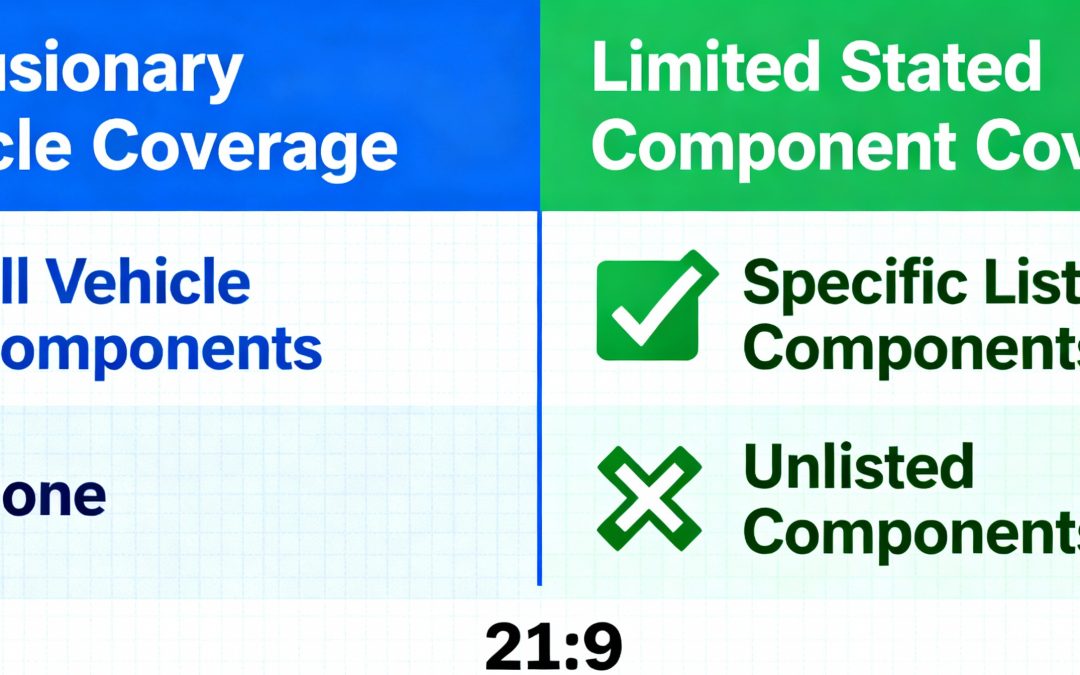Exclusionary Extended Warranty vs Stated Component: 5 Critical Differences in 2025
Quick Answer: An exclusionary extended warranty covers everything except a short list of exclusions (1,000+ parts), while stated component coverage only protects the 50-150 parts explicitly listed in your contract. The #1 complaint about vehicle service contracts is "the part that broke wasn't covered"—a problem that exclusionary extended warranty coverage solves by protecting nearly everything that can fail on your vehicle. If it can break and isn't covered, it will break when you need protection most.

When you're evaluating extended warranty options, understanding the difference between exclusionary extended warranty and stated component coverage determines whether you'll face claim denials when your vehicle needs expensive repairs. The exclusionary extended warranty approach covers your entire vehicle except for a short list of maintenance items and wear parts, while stated component (also called inclusionary) coverage only protects the specific parts listed in your contract—leaving thousands of components completely unprotected.
According to consumer protection agencies and Better Business Bureau data, the most common complaint about vehicle service contracts isn't about cost or claims processing—it's about discovering that the failed part isn't covered. This frustrating scenario occurs almost exclusively with stated component plans where owners assumed they had comprehensive protection, only to learn during a breakdown that the expensive component isn't on the limited coverage list. Exclusionary extended warranty eliminates this problem entirely by protecting everything unless specifically excluded.
What Is an Exclusionary Extended Warranty?
An exclusionary extended warranty (sometimes called "bumper-to-bumper" coverage, though that's not technically accurate) uses a coverage model that protects nearly every mechanical and electrical component on your vehicle. Instead of listing what's covered, exclusionary extended warranty contracts list what's NOT covered—typically just maintenance items, wear parts, and cosmetic components. Everything else receives protection.
This coverage approach delivers maximum transparency because you can quickly identify the short list of exclusions (usually 20-40 items) rather than trying to find specific components within a list of hundreds of covered parts. With exclusionary extended warranty protection, when something breaks, it's covered—period. No guessing, no claim disputes, no unexpected expenses for components you assumed were protected.
Exclusionary Extended Warranty vs Stated Component Coverage: The Critical Differences
The fundamental difference between exclusionary extended warranty and stated component coverage determines whether you face claim denials and unexpected repair bills. Here's what separates these approaches:
| Feature | Exclusionary Extended Warranty | Stated Component Coverage |
|---|---|---|
| Coverage Approach | Covers everything EXCEPT short exclusion list | Covers ONLY parts on inclusion list |
| Parts Protected | 1,000+ components | 50-150 components (varies by plan) |
| Claim Denial Risk | Very Low - Nearly everything covered | High - Most parts NOT listed |
| Transparency | Clear - Short exclusion list easy to review | Confusing - Must search long list for specific parts |
| Modern Vehicle Systems | All sensors, switches, modules covered | Often excluded or not listed |
| Hybrid/EV Components | Drive motors, controllers, inverters covered | Battery often excluded, other parts unlisted |
| Infotainment Systems | Fully covered (navigation, touchscreens, modules) | Usually excluded or expensive add-on |
| ADAS Technology | Lane assist, parking sensors, cameras covered | Rarely listed in stated component plans |
| Monthly Cost | $95-$225 (comprehensive protection) | $60-$150 (limited protection) |
| Peace of Mind | Complete - Know you're protected | Uncertain - Always wondering about coverage |
The cost difference between exclusionary extended warranty and stated component coverage—typically $30-75 per month—becomes irrelevant when a single uncovered repair costs $1,800-$3,500. The stated component savings evaporate the first time an expensive unlisted part fails.
The #1 Complaint: “The Part That Broke Wasn’t Covered”
Consumer protection agencies, Better Business Bureaus, and automotive consumer advocates report the same dominant complaint about vehicle service contracts: owners discover after a breakdown that the failed component isn't covered by their stated component plan. This scenario occurs thousands of times daily across the country, creating frustration, financial hardship, and damaged trust in the warranty industry.
Why This Happens
Several factors contribute to the "part not covered" complaint epidemic:
- Sales presentations emphasize benefits of exclusionary coverage - Buyers hear about comprehensive protection and assume that's what they're purchasing
- Stated component lists are complex and long - Buyers don't review the 15-25 page component list or understand what's missing
- Many sales professionals genuinely believe stated component is comprehensive - They've been trained that their product protects "most parts" without understanding how many components are excluded
- Profit margins favor stated component plans - These products cost less to provide, creating higher margins that incentivize their sale over exclusionary extended warranty coverage
- The sale happens years before the problem - By the time a claim is denied, the sales professional has usually moved on, leaving no recourse for the frustrated owner
Exclusionary extended warranty eliminates these problems because what you're told matches what you're getting: comprehensive protection for nearly everything that can fail.

10 Expensive Parts Excluded from Most Stated Component Plans
Here are ten common, expensive components that fail regularly but typically aren't covered by stated component warranties—all of which receive protection under exclusionary extended warranty coverage:
| Component | Average Repair Cost | Why It Fails | Stated Component | Exclusionary |
|---|---|---|---|---|
| Mass Airflow Sensor | $300 - $650 | Contamination, age | ✗ Not listed | ✓ Covered |
| Throttle Position Sensor | $250 - $550 | Wear, carbon buildup | ✗ Not listed | ✓ Covered |
| Infotainment Head Unit | $800 - $2,500 | Electronics failure | ✗ Extra cost | ✓ Covered |
| Backup Camera | $400 - $900 | Moisture, failure | ✗ Not listed | ✓ Covered |
| Lane Keeping Assist Sensors | $600 - $1,400 | Calibration, failure | ✗ Not listed | ✓ Covered |
| Parking Assist Sensors | $400 - $800 | Impact, failure | ✗ Not listed | ✓ Covered |
| Hybrid Drive Motor | $2,500 - $5,000 | Inverter failure | ✗ Not listed | ✓ Covered |
| Hybrid Power Control Module | $1,200 - $2,800 | Electronics failure | ✗ Not listed | ✓ Covered |
| Electronic Stability Control | $800 - $1,600 | Sensor failure | ✗ Not listed | ✓ Covered |
| Adaptive Suspension Modules | $900 - $2,200 | Electronics, sensors | ✗ Not listed | ✓ Covered |
| TOTAL (All Failures) | $9,150 - $18,400 | One failure costs more than a year of exclusionary extended warranty premiums | ||
Modern vehicles rely on hundreds of sensors, switches, relays, and electronic modules that stated component plans simply don't list. If a part isn't specifically named in your stated component contract, it's not covered—period. Exclusionary extended warranty protects all of these expensive components because they're not on the short exclusion list.
Why Dealers Often Don’t Offer Exclusionary Extended Warranty
If exclusionary extended warranty provides superior protection, why do dealerships predominantly offer stated component or "powertrain plus" coverage? The answer involves markup structure and profit margins rather than malicious intent:
- Stated component plans cost less to provide - The wholesale cost to dealers is significantly lower because coverage is limited
- Lower cost creates higher profit margins - Dealers can mark up stated component plans more aggressively while keeping the retail price competitive
- Multiple middlemen increase costs - Warranty products pass through vendors, administrators, insurance companies, and marketing agencies before reaching customers, each taking a margin
- Sales commissions incentivize certain products - Compensation structures may favor stated component sales over exclusionary extended warranty offerings
- Many employees genuinely don't understand the difference - Training emphasizes selling rather than educating about coverage limitations
This creates a system where buyers pay for perceived exclusionary extended warranty benefits while receiving stated component coverage—fueling the #1 complaint about parts not being covered. The solution requires transparency: clear explanation of what's covered, honest comparison of coverage types, and elimination of unnecessary middlemen who inflate costs without adding value.
Real Repair Scenarios: Exclusionary Extended Warranty vs Stated Component
Understanding coverage differences becomes clear through real-world repair scenarios. Here's how exclusionary extended warranty and stated component plans handle common expensive failures:
Scenario 1: Infotainment System Failure
Vehicle: 2018 Honda Accord with 92,000 miles
Problem: Touchscreen frozen, navigation non-functional, backup camera black screen
Diagnosis: Head unit failure requiring replacement
Repair Cost: $1,850 (parts $1,400 + labor $450)
Stated Component Outcome: Claim denied. Infotainment not listed in covered components. Owner pays $1,850 out-of-pocket unless they purchased expensive electronics add-on.
Exclusionary Extended Warranty Outcome: Claim approved. Infotainment covered under exclusionary policy. Owner pays deductible ($0-$300) only.
Scenario 2: Mass Airflow Sensor Failure
Vehicle: 2017 Ford F-150 with 115,000 miles
Problem: Check engine light, rough idle, poor fuel economy
Diagnosis: Mass airflow sensor contaminated and failed
Repair Cost: $485 (parts $320 + labor $165)
Stated Component Outcome: Claim denied. MAF sensor not specifically listed. Powertrain coverage doesn't include sensors. Owner pays $485 out-of-pocket.
Exclusionary Extended Warranty Outcome: Claim approved. All engine sensors covered. Owner pays deductible ($0-$300) only.
Scenario 3: Hybrid Drive Motor Failure
Vehicle: 2016 Toyota Prius with 128,000 miles
Problem: Electric motor not engaging, hybrid system warning light
Diagnosis: Electric drive motor inverter failure
Repair Cost: $3,600 (parts $2,900 + labor $700)
Stated Component Outcome: Claim denied. Hybrid drive components not listed (battery might be covered as expensive add-on, but motor/inverter excluded). Owner pays $3,600 out-of-pocket.
Exclusionary Extended Warranty Outcome: Claim approved. All hybrid drivetrain components except battery covered (note: hybrid batteries typically have separate long-term manufacturer warranty). Owner pays deductible ($0-$300) only.
These scenarios demonstrate why exclusionary extended warranty eliminates the #1 warranty complaint. When something breaks, you know it's covered—no uncertainty, no surprise denials, no financial crisis from unexpected repair bills.

The Industry Problem: Too Many Middlemen
Traditional warranty distribution involves multiple layers that inflate costs without improving coverage or service:
- Vendor/Warranty Company - Creates the product, sets wholesale pricing
- Administrator - Handles claims processing, adds administrative margin
- Insurance Company - Backs the contract, charges for risk coverage
- Marketing Agency - Generates leads, takes marketing fees
- Dealer/Finance Manager - Sells the product, adds retail markup
Each layer adds 15-30% to the cost, meaning buyers pay 2-3x the actual coverage value. This complexity also creates confusion: when claims are denied, who's responsible? The dealer blames the administrator, the administrator blames the vendor, the vendor points to contract language—while the frustrated owner just wants their car fixed.
Exclusionary extended warranty from direct providers eliminates unnecessary middlemen, reducing costs by 30-40% while delivering superior coverage. Simpler structure also means clearer communication: one company handles enrollment, claims, and service, eliminating finger-pointing when issues arise.
VIP Warranty: Simple, Transparent, Reliable Exclusionary Extended Warranty
VIP Warranty solves every problem with traditional vehicle service contracts by offering true exclusionary extended warranty coverage through a straightforward monthly subscription model:
Why VIP’s Exclusionary Extended Warranty Works
- Covers vehicles up to 250,000 miles - Protection when you need it most, unlike traditional warranties that stop at 150,000 miles
- No inspection required - Streamlined enrollment eliminates hassle and delay
- Cancel anytime with no penalties - Payments stop immediately, no prorated refunds or cancellation fees
- Deductible drops to $0 after 6 months - Loyalty reward that saves $300 per repair for life
- Maximum 5% annual increases guaranteed - Predictable costs versus 15-20% jumps with traditional plans
- True exclusionary coverage - 1,000+ parts protected, not stated component with limited list
Most importantly, VIP eliminates the #1 warranty complaint by providing genuine exclusionary extended warranty coverage. When your infotainment fails, your sensors malfunction, or your hybrid components break, you're covered. No uncertainty, no surprises, no denied claims for unlisted parts.
Frequently Asked Questions About Exclusionary Extended Warranty
Making the Smart Choice: Exclusionary Extended Warranty for Complete Protection
The choice between exclusionary extended warranty and stated component coverage determines whether you face surprise repair bills and claim denials or drive with complete peace of mind. The evidence is overwhelming:
- Exclusionary coverage protects 1,000+ parts - Nearly everything that can fail receives protection
- Stated component covers only 50-150 parts - Thousands of components remain unprotected
- The #1 warranty complaint stems from stated component limitations - "Part not covered" frustration occurs almost exclusively with limited coverage
- Modern vehicles need comprehensive protection - Sensors, switches, electronics, hybrid components, and ADAS technology require exclusionary extended warranty coverage
- One uncovered repair erases years of stated component savings - The $30-75 monthly difference becomes irrelevant facing $1,800-$3,500 bills
- Transparency matters - Short exclusion list versus long inclusion list reveals true coverage scope
Stop wondering if you're covered. VIP Warranty's exclusionary extended warranty protects 1,000+ components with transparent pricing, zero claim denial surprises, and direct service that eliminates warranty industry complexity. Contact us or use live chat to speak with a warranty specialist who can explain exactly what exclusionary coverage protects—and why stated component plans leave you vulnerable to the industry's #1 complaint.
References & Additional Resources
- Federal Trade Commission - Auto Service Contracts
- ConsumerAffairs - Inclusionary vs Exclusionary Warranty
- California Department of Insurance - Service Contract Guide
- Used Car Extended Warranty Cost Guide
- VIP Warranty Exclusionary Coverage Pricing
- Toyota Extended Warranty Guide
- Honda Extended Warranty Guide

